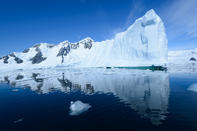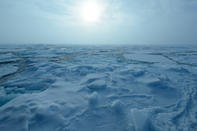‘Heat In’
Most of our heat comes from the Sun. Of that energy reaching our outer atmosphere, just over half makes it through to the surface of the Earth. The angle at which the heat strikes the atmosphere influences how much makes it through.

An acute angle, closer to the equator, means less atmosphere to pass through and more heat penetration; an obtuse angle closer to the poles means more atmosphere to interrupt the heat so less reaches the ground.
For this reason, the poles are colder than the equator and the same principle shifts the mercury between winters and summers in the two hemispheres. The remaining energy is either reflected back out to space by clouds, dust or snow on the Earth's surface or is absorbed by clouds. Some heat is trapped near the surface by greenhouse gases, keeping the planet snug and warm, except for those few extreme places. '
Heat in' changes as the Sun pulses. This is associated with the tidal action of the Sun and occurs in 22-year cycles: in fact, two 11-year cycles during which solar activity reaches a maximum and a minimum. Such activity has been written in the growth rings of Ponderosa pines in Arizona, which show growth spurts during warmer periods.
An increase in solar activity is associated with increases in temperature and more rain in the Northern Hemisphere; less activity produces a decrease in temperature and a decline in rainfall there. The Earth's path around the Sun is not entirely as rigid as suggested earlier.
The Earth's Orbit

The Earth's orbit follows three distinct cycles. These are grouped together as the Milankovitch cycles, named after the Serbian scientist who calculated their oscillations many decades before the scientific community finally accepted them.
Milutin Milankovitch made a correlation between the clockwork regularity of ice ages and the Earth's orbiting cycles. He first found that Earth's path around the Sun is not constant, but stretches its elastic orbit between a circular and elliptical course every 100 000 years.
This changes our distance from the heat source and has a profound impact on global climate, triggering glacial and interglacial cycles that correspond to the 100 000 year cycle. Another two cycles repeat more regularly: every 42 000 years the Earth's axis tilts between 21.6° and 24.5° on its equatorial plane, while every 22 000 years the axis wobbles like 'a top about to fall'.
The latter movement, known as the precession, wobbles the planet between two phases: every 22 000 years, when the angle of precession puts the Northern Hemisphere closest to the Sun during its summer, it will receive the most concentrated sunshine, mirrored by warmer temperatures for the region; 11 000 years later, when the precession is at the opposite side of the cycle, the Northern Hemisphere will be further from the Sun during its summer time that region will drop.
‘Heat Out’

How much heat the Earth retains depends on two things - the amount of greenhouse gases present in the atmosphere, and how light or dark the surface of the Earth is.
It makes sense that if you increase the amount of greenhouse gases trapping heat, you will increase the amount of heat that stays in the system. It's like pulling on a thicker sweater - you trap more body heat and warm up. Meanwhile, light surfaces such as snow and ice send a lot of energy back out to space, like tin foil reflecting heat. Darker surfaces such as forests absorb heat.
This so-called albedo effect is crucial in regulating the thermal state of things. The more ice there is, the less heat stays. Ice ages are believed to be triggered not by winter getting colder, but by summer not warming.
If summer does not warm enough to melt the most recent deposit of snow, the white covering remains and keeps redirecting heat out to space, causing the planet to spiral into freezer conditions. But, for this to happen, the system has to be close to a tipping point.
Various other things have shaped the climate at a local level. The tectonic movement that pushed up the Himalayan mountains by smashing together the Indian continental and South-East Asian plates to produce an almost impassable barrier of rock and the highest summit on the planet, single-handedly, created the South-East Asian monsoon.
This movement, and the formation of the Isthmus of Panama, are believed to have disrupted ocean and air circulations sufficiently to trigger ice ages after their formation. The system ticks over like clockwork, producing oscillations between warmer and cooler periods.
Life on Earth evolved to this steady and reliable cadence. Even species such as the wandering albatross, who live so remotely from the source of the pollution, will feel the heat of global climate change.
By Leonie Joubert